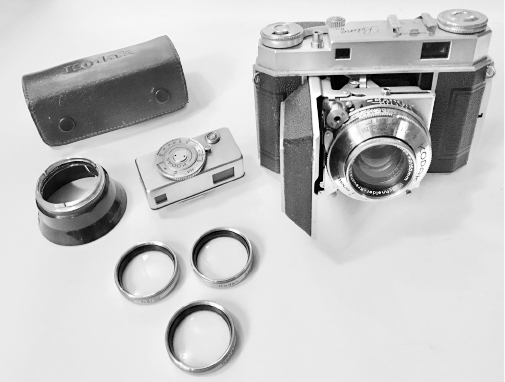Germany was famous for its cameras, particularly in the 1930s, 1940s and 1950s. The quality of brands such as Leica, Zeiss and Voigtlander was legendary. However after WW2 the Japanese, with their vastly improved, and innovative quality control started by copying many German cameras (helped by the cancellation of German patents). Eventually, with the introduction of SLRs, they began to dominate the market. Today, Leica is virtually the only survivor.
1925 Contessa Nettel Cocarette
According to Camera-Wiki “The Cocarette was a non-self erecting folding camera for rollfilm. It was one of the first new products of the German camera maker Contessa-Nettel after the merger that led to the foundation of that company in 1919. The Cocarette camera series was continued after Contessa-Nettel itself was merged into the Zeiss Ikon group. Like many other folding camera types of the 1920s it was available in a variety of configurations. After the formation of Zeiss Ikon the Cocarette was given the model number ‘519’, with variations 519/14, 519/2, 519/15, denoting the film format. There was also a postcard format 522/17. Focusing was by a lever on the folding bed shifting the lens assembly forward or backward. Advanced versions were made which allowed vertical lens movements. The cameras all had a brilliant viewfinder, some incorporating spirit levels; some models also feature a wire frame sportsfinder. The original Contessa-Nettel design tried to simplify film loading with an insert that slides into the camera. This loading mechanism also meant a circular door in the back of the camera was provided to allow access to the lens for cleaning or removal. Production must have ceased c.1930 as the Cocarette does not appear in Zeiss Ikon’s 1931 catalogue”

1930 Voigtlander AVUS
This 6.5 x 9cm camera is one of a series of folding plate cameras made by Voigtlander from 1913 to 1934. These cameras came in both 6.5x9cm and 9x12cm versions. They have double extension bellows and are equipped with Ibsor or Compur shutters, this example has a Compur with speeds from 1 to 1/250th. Also a Jena Tessar 120mm F4.5 lens is fitted. There is a small amount of both rise/fall and lateral shift movement. With my camera are a number of very rare Rada “Rollfilm-Kassettes”.
The name Avus was taken from speedway car racing circuit in Berlin, the first in Germany.


1933 Zeiss Ikon NETTAR 515/2
The Nettar series by Zeiss Ikon was a successful range of self-erecting folding cameras for 120 roll film. Zeiss Ikon always advertised the Nettar series as being for the amateur photographer, however these cameras share many parts with the much more expensive Ikonta series so the build quality is excellent. On this example the lens mounted viewfinder is missing.

1935 KODAK Retina 1 (118)
Although branded a Kodak, these were made in West Germany by Nagel Camera Werks AG which Kodak had acquired in December 1931.
This camera was used by Sir Edmund Hilary on his successful first ever ascent of Mount Everest in 1953. The slightly earlier type 117 was the first camera to use daylight loading 35mm cassettes (known as 135) invented by Kodak in 1934.
It has a Compur shutter with speeds from 1/500th to B and T. The Schneider-Kreuznach Xenar f3.5 50mm lens has a reputation for sharpness, albeit uncoated.
In 1953 Sir Edmund Hillary bought his second-hand and only modified it slightly so it could be wound-on with gloves. To quote Scott Bilotta “It’s interesting that the Retina was bought second hand. I think that could be a testament to the quality of the Retina series of cameras”.

1951 KODAK Retina lla
This camera was purchased new by my father in West Africa after he lost his his Agifold in a motor accident.
“The Kodak Retina IIa is a favorite of the long lived Retina series, the epitome of a classic small fast lensed 35mm folder. It is so good due to It’s small size, superb 50/2 Xenon lens, better than average finder, quiet leaf shutter, and the simple straightforward design which translates to pleasurable shooting. The IIa was produced only from 1951 to 1954, yet over 100,000 were produced. In a nutshell, many Retina fanatics feel the earlier Retinas had less of the desirable features, while the later Retinas sacrificed too much size and weight for additional features”.
In the illustration is the original close-up attachment for the camera. There was also a Gossen Sixti exposure meter which clipped into the accessory shoe. This was stolen (along with other photographic items) but I have recently bought another from eBay!

1954 KODAK Retinette
Manufactured from 1954 to 1958. This model was the first of the rigid front Retinettes. Fitted with a Schneider Reomar 45mm f/3.5 lens in a Compur-Rapid shutter it was made in the same factory as the more expensive Retina.

1962 Ilford Sporti
This was my first ‘proper’ camera (after a box camera). Although branded by British Ilford, it was, in fact, made by Dacora in West Germany. Taking 120 film and making 6 x 6 negatives, it was very basic with zone focusing with a minimum distance of 5 feet. There are two apertures , f11 and f8. The shutter speed is fixed at 1/50th.

1964 Praktica IVF
Made by VEB Pentacon in East Germany, this my first serious camera, the cheapest SLR available at the time.
It was fitted with an instant return mirror, differentiating it from the Practica IV. Speeds were 1/2-1/500 +B, and the lens fitted was a Meyer Domiplan which I described as having the resolution of the bottom of a beer bottle (I couldn’t afford the better Zeiss Jena Tessar, also 50mm F2.8).
